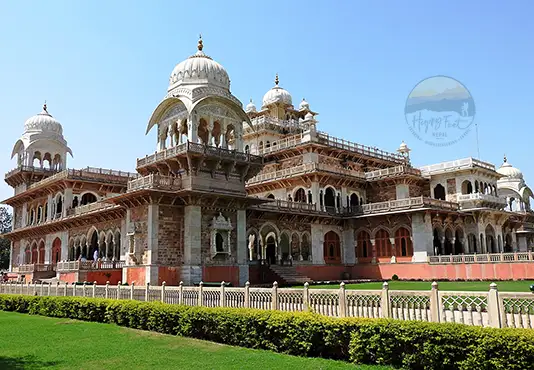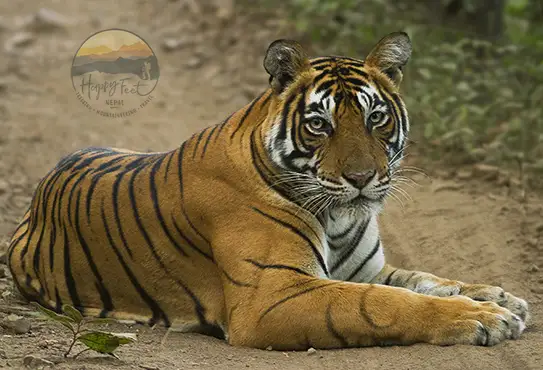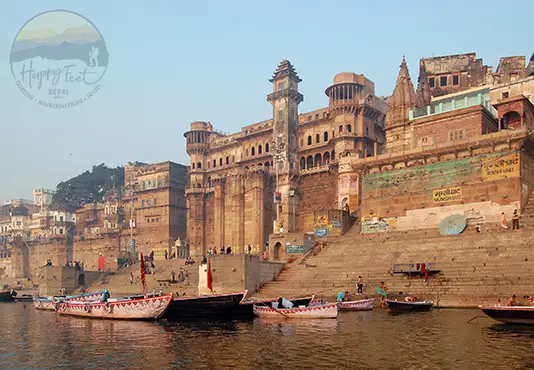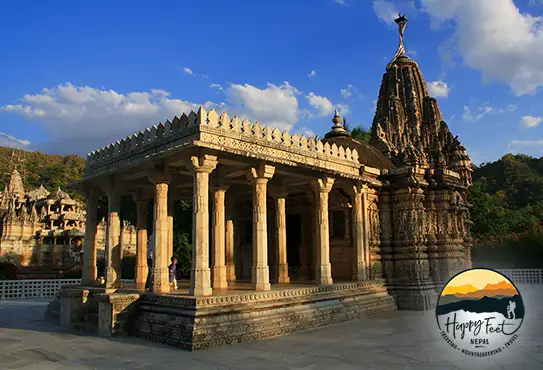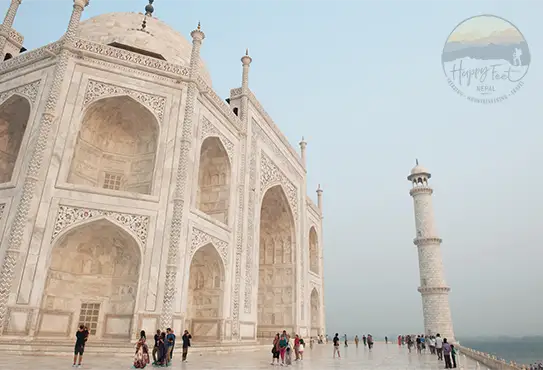-
Sunday - Friday: 9 AM - 4 PM
Experience the Golden Triangle Tour, starting in the vibrant blend of tradition and modernity of Delhi. Explore iconic sites like the Red Fort, Jama Masjid, and Taj Mahal in Agra. Explore the Amber Fort and Mandawa’s frescoes in Jaipur and discover the rich cultural heritage of India.
Explore the captivating essence of India through the Golden Triangle Tour 7-Days, which spans the iconic cities of Delhi, Agra, Jaipur, and Mandawa over seven unforgettable days. This tour promises a blend of rich history, architectural marvels, and cultural experiences, making it an ideal journey for those eager to explore the vibrant heritage of India.
The Golden Triangle Tour 7-Days, commencing in Delhi, the capital city, unfolds layers of tradition and modernity. The wonder begins upon your arrival at the airport, warmly welcomed by a Happy Feet Mountaineers representative and transferred to your hotel. After a leisurely day to introduce Indian traditions, prepare to delve into the historical realms of Old and New Delhi the following day. Experience the buzz of Old Delhi as you navigate through its bustling streets full of shops, winding gullies and lanes full of street food on a rickshaw, visiting notable historical sites such as the Red Fort and Jama Masjid while also witnessing the serene atmosphere at the Bangla Sahib Sikh Temple. Transitioning to New Delhi, marvel at the majestic architecture of Humayun’s Tomb, the India Gate, and the impressive Qutub Minar.
The journey continues to Agra, where the masterpiece of the Taj Mahal awaits your discovery. This eternal symbol of love, built by Shah Jahan for his beloved wife, is often regarded as one of the most stunning architectural feats in the world. Your exploration includes the majestic Agra Fort and local marble factories, allowing you to appreciate both history and craftsmanship.
Moving on to Jaipur, the Pink City, you will find a similar architectural splendour reflected in the Amber Fort and the City Palace, which blend Rajput and Mughal styles. The charm of Jaipur also lies in its rich cultural heritage, and you will have the opportunity to explore this through its colourful markets and exquisite havelis. Finally, experience the hidden gem of Mandawa, renowned for its captivating frescoes and historic mansions, and round off your journey with a deep appreciation for the diverse cultural fabric of India.
This Golden Triangle Tour promises a transformative experience filled with memories that will reverberate long after the journey concludes.
Arrive at Delhi Airport, customs and immigration formalities and claim your baggage, which takes some time. Upon exiting the arrivals get a traditional welcome from the Happy Feet Mountaineers representative and transfer to the hotel (room check-in is available from noon). Rest of the day at leisure
Morning breakfast at the hotel. Later, full-day Visit to Old & New Delhi. Visit Old Delhi in Ricksaw. Starting the drive past Red Fort, visit the Bangla Sabih Sikh Temple and observe the fervour with which the Brotherhood members listen to the Book reading. Then visit the Great Jamma Masjid Mosque, built by the Shah Jahan, rising in the middle of the old city of Old Delhi. Lunch at a local restaurant.
In New Delhi, we pass through the Rajpath, Visit Humayun Tomb, the city Edwin Lutyens built to be the British capital in the so-called Anglo-Indian style, and the India Gate memorial erected in honour of the soldiers who died during various wars. Parliament Building, Presidential Palace, and ministries. Later visit the Qutub Minar, the oldest monument in Delhi, declared a World Heritage Site in 1993.
This morning we will continue to Agra, either by road or air-conditioned train, schedules permitting. Arrive at Agra and check into the hotel. Free time for lunch and visit Agra, including the red Fort and Marble factory. The imposing Red Fort, or red sandstone Agra Fort, was principally erected as a military establishment by Akbar in 1565 and was partially converted into a palace during Shah Jahan’s time. Agra is also famously known as the city of Marble; therefore, visit its marble factories. This evening one can explore the markets of Agra on foot and buy souvenirs for families. Overnight at Hotel.
This morning we take a sunrise visit to the main attraction of Agra: The Taj Mahal, one of the world’s most beautiful buildings. Called “A dream in marble,” the Taj Mahal was built by Shah Jah as a memorial to his queen Mumtaz Mahal. Shah Jah built the Taj to enshrine the body of his favourite wife, Mumtaz Mahal (the elect of the palace), who died shortly after the birth of their 14th child in 1631. The Taj Mahal – often described as the most extravagant monument ever built monument of love constructed by 20,000 men from Asia commenced in 1632 and was completed in 1653. The marble used for the monument was brought from Makrana, near Jodhpur, and precious stones of amethyst, malachite, onyx, lapis lazuli, turquoise, jade, crystal and mother of pearl were brought from Persia, Russia, Afghanistan, Tibet, China and the Indian Ocean.
Finalize the visit, return to the hotel for breakfast, and transfer to Jaipur by road. En route, visit the Fatehpur Sikri, the “ghost city”, built by the 28 Year young Emperor Akbar on a rocky ridge. The city’s history began when Akbar, desperate for not having an heir, decided to see a Muslim holy man, Salim Chisti, who blessed Akbar. Therefore, the emperor had a long-awaited son, whom he named Salim, in honour of the Muslim saint. Salim would one day take the throne from Jahangir. The grateful Akbar decided to move his capital to the small town where he died in 1569. Fatehpur Sikri stands on a rocky ridge for 2 miles. He raised his hand at the foot of the cliffs and created an artificial lake that extended 20 miles in all directions. Walking through the Fatehpur Sikri’s empty palaces, one cannot but be transported back 400 years and visualize the glory and the splendour that must have existed.
After the visit continue your drive to Abhaneri stepwell. visit Abhaner without a guide, originally called Abha Nagri, which means “The Shining City”. Abhaner has “Baoris” (stairwells), which are the invention of the natives to collect rainwater. Finalize the visit and continue your drive to Jaipur, known as the Pick City. Arrive at Jaipur and check into your hotel.
Jaipur, known as the Pick City. the capital of Rajasthan, still seems cradled and well-protected. Jaipur is named after Maharaja Jai Singh, who became King of Amber in the early 1700s at the age of thirteen. Despite his precocious age, he was a distinguished student adding to his credentials the careers of architecture and astronomy. He designed the new capital with exquisite pink terracotta buildings, which gave it the name “pink city” with the colours pink and orange as predominant colours; the sunset effect is magical.
Breakfast at the hotel. Later visit the Amber Fort, stunningly situated on a hillside overlooking a lake, 11km from Jaipur. Amber was the capital of Rajasthan for six centuries and the core land of Rajput history. Nowadays, the city is practically abandoned. The objective of the visit is to see and admire its imposing palace. The palace stands on the steep hill slope behind Maota Lake, retaining an air of great beauty. The visit to the palace can be done on foot, by Jeep or by an elephant back safari, the most preferred. The construction of the Palace/Fort was initiated in the 1592s by Raja Man Singh, the Rajput commander of Akbar’s army and later extended and completed by Jai Singh. The “Hall of Public Audience,” with a double row of columns and latticed galleries, is reached by an imposing stairway. The Fortress also contains a temple dedicated to Goddess Kali, having doors made of Silver. Next, walk over to the: Hall of Victory, noted for its inlaid panels and glittering mirror ceiling. The “Hall of Pleasure” is on the opposite side with an ivory-inlaid sandalwood door and the “Hall of Private Audience” is extraordinary with exquisite murals. However, the highlight of the Fort is the “Hall of Mirrors”, whose interior is encrusted with tiny mirrors, showing like a sparkling diamond in candlelit. The oldest part of the palace is Raja Man Singh’s apartments, where each of his dozen wives had a separate suite.
Afternoon: Tour of Jaipur City. Jaipur city is a living testament to one of the most remarkable rulers of his age, Jai Singh II, an extremely talented ruler in politics and battle. However, the credit for the pinkness of the city goes to Maharaja Man Singh, who dressed up the city in the welcoming symbolic colour following the visit of the Prince of Wales and, later, Edward VII, who visited Jaipur in the 1876s.
The City Palace and Museum visit comprises several courtyards, gardens, and buildings and blends Rajasthani and Mogul architecture. The former Maharaja still lives in one of its wings and dates back to the 18th century with a mixture of Rajput and Mughal styles. The museum contains an extensive collection of art, miniature paintings, carpets, costumes and dresses, enamelware, old weapons, and an armoury of guns and swords. The Jantar Mantar, a great astronomical observatory built in 1728 by Jai Singh and Hawa Mahal or Palace of the Winds, built in the 1799s, that we need to see from outside, is Jaipur’s most famous monument of Rajput architecture and consists of 5 floors of which only the multi-windowed façade remains.
NOTE: The Archeology department has limited the number of trips and times to go up to Amber Fort by elephant, so it is possible that Amber Fort cannot be accessed on the day of the visit, and we have to do it by jeep. Therefore, an elephant back tour cannot be guaranteed.
Breakfast and set off for Mandawa, 160 kilometres out of Jaipur. Upon arrival at Mandawa, we check into our hotel, where the ambience reflects the heritage of the region with a blend of comfort and tradition of Mandawa elegance.
Mandawa, known for its majestic forts and intricately designed havelis, is one of the quaint gems of India. The 18th-century Mandawa town boasts a rich history that echoes through its grand structures. The quaint gem Mandawa is an Open Art Gallery for its stunning architectural artistry. Mandawa is filled with marvellous mansions and vibrant frescoes, making it a not-to-miss destination in central Rajasthan.
In the afternoon, start the exploratory journey of the beautifully preserved havelis that tell tales of affluent merchant families from a bygone era. Among these architectural wonders is the Hanuman Prasad Goenka Haveli, renowned for its exquisite paintings that vividly depict Lord Shiva seated on a majestic Nandi bull and Indra Dev riding gracefully on an elephant. Next is the Jhunjhunwala Haveli, a charming room painted with gold leaf that exudes grandeur and artistry. The charm continues at the Mohan Lal Saraf Haveli, famous for its captivating depiction of the Maharaja confidently stroking his moustache, embodying royal grandeur. For the ultimate feast for the eyes and mind, visit the Akharam Ka Haveli, a timeless structure that has stories to tell.
After the exploration and cultural immersion, we return to our hotel for an overnight stay, allowing the charm of Mandawa to linger in our hearts.
Breakfast and drive to New Delhi. Arrive in New Delhi and free time to enjoy shopping in the bustling markets of Delhi. In the evening, we farewell you and transfer you to the airport, check-in formalities, pass through immigration and depart for your onward destination.
